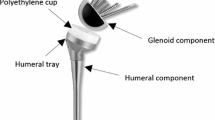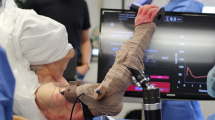Abstract
Objective
Shoulder arthroplasty with a humeral head prosthesis is used to treat complex proximal humeral fractures, and the outcome depends on the placement and integrity of sutures. The object of this research is to determine the forces supported by sutural filaments that bind the tuberosities to the prosthesis in proximal humeral fractures. Knowledge of these forces facilitates comparison of different suturing strategies that may improve the surgical procedure and provide better outcomes.
Method
A robotic workstation and a set of sensor modules were designed and built to emulate post-surgery rehabilitation geometry and forces with the required precision and repeatability. This system allows monitoring the forces supported by each sutural thread, as well as measurement of the millimeter scale displacements between the bone fragments produced postoperatively during rehabilitation movements. Several common suturing strategies carried out by orthopedists in shoulder arthroplasty with placement of a humeral head prosthesis were emulated using the robotic system.
Results
Based on in vitro laboratory experiments, the shoulder arthroplasty suture that supports higher strains was identified. The sutural band with maximum stress was not the same when the humerus is immobilized after surgery and in the postoperative rehabilitation phase.
Conclusion
The robotic system for shoulder arthroplasty with humeral head prosthesis placement provides biomechanical insight with quantitative analysis of the force distribution regarding the suturing strategy used in the procedure. The suture most likely to fail early when increasing tension in the rotator cuff muscles is the one passed through both tuberosities. The clinical significance of these findings is identification of the need to avoid shortening the humeral height or increasing retroversion in this procedure.
Similar content being viewed by others
References
Kralinger F et al (2004) Outcome after primary hemiarthroplasty for fracture of the head of the humerus. J Bone Joint Surg Br 86: 217–219
Boileau P, Krishnan SG, Tinsi L, Walch G, Coste JS, Molé D (2002) Tuberosity malposition and migration: reasons for poor outcomes after hemiarthroplasty for displaced fractures of proximal humerus. J Shoulder Elbow Surg 11: 401–412
Takanobul H et al (1998) Quantification of masticatory efficiency with a mastication robot. In: IEEE international conference on robotics & automation
Xu WL, Bronlund J, Kieser J (2005) Choosing new ways to chew: a robotic model of the human masticatory system for reproducing chewing behaviors. Robot Autom Magn, vol 12, issue 2
Nishikawa K et al (2003) Modeling and analysis of elastic tongue mechanism of talking robot for acoustic simulation. In: IEEE/RSJ international conference on intelligent robots and systems
Mizuuchi I et al (2002) The design and control of the flexible spine of a fully tendon-driven humanoid, Kenta. In: IEEE/RSJ international conference on intelligent robots and systems
Debski RE et al (2005) Stress and strain in the anterior band of the inferior glenohumeral ligament during a simulated clinical examination. J Shoulder Elbow Surg
She H (2004) Programming by demonstration in the application of rehabilitation robots, PhD Thesis, University of Bremen
Billard A, Dillmann R (eds) (2006) The social mechanisms of robot programming by demonstrations, special issue. Intell Auton Syst, vol 54, no. 5
Frigola M, Poyatos J, Casals A, Amat J (2003) Improving robot programming flexibility through physical human–robot interaction. In: IEEE IROS-workshop on robot programming by demonstration
Author information
Authors and Affiliations
Corresponding author
Rights and permissions
About this article
Cite this article
Casals, A., Amat, J., Frigola, M. et al. Monitoring and robotizing shoulder arthroplasty for training and optimization of suturing techniques. Int J CARS 3, 61–67 (2008). https://doi.org/10.1007/s11548-008-0200-2
Received:
Accepted:
Published:
Issue Date:
DOI: https://doi.org/10.1007/s11548-008-0200-2




